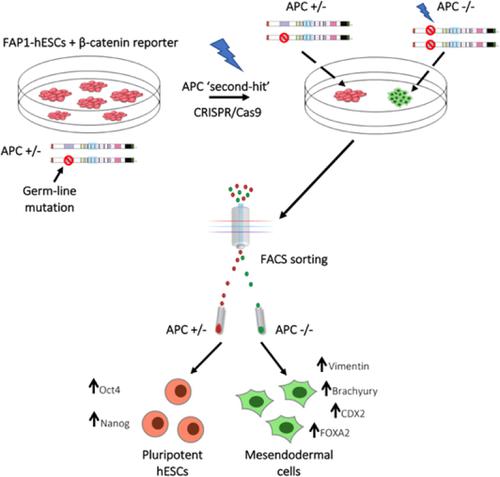当前位置:
X-MOL 学术
›
STEM CELLS
›
论文详情
Our official English website, www.x-mol.net, welcomes your
feedback! (Note: you will need to create a separate account there.)
APC as a major regulator of hESCs self-renewal
STEM CELLS ( IF 4.0 ) Pub Date : 2019-11-04 , DOI: 10.1002/stem.3084 Livia Preisler 1, 2 , Dalit Ben-Yosef 1, 2 , Yoav Mayshar 1
STEM CELLS ( IF 4.0 ) Pub Date : 2019-11-04 , DOI: 10.1002/stem.3084 Livia Preisler 1, 2 , Dalit Ben-Yosef 1, 2 , Yoav Mayshar 1
Affiliation

|
Human embryonic stem cells (hESCs) provide an essential tool to investigate early human development, study disease pathogenesis, and examine therapeutic interventions. Adenomatous polyposis coli (APC) is a negative regulator of Wnt/β‐catenin signaling, implicated in the majority of sporadic colorectal cancers and in the autosomal dominant inherited syndrome familial adenomatous polyposis (FAP). Studies into the role of Wnt/β‐catenin signaling in hESCs arrived at conflicting results, due at least in part to variations in culture conditions and the use of external inhibitors and agonists. Here, we directly targeted APC in hESCs carrying a germline APC mutation, derived from affected blastocysts following preimplantation genetic diagnosis (PGD) for FAP, in order to answer open questions regarding the role of APC in regulating pluripotency and differentiation potential of hESCs. Using clustered regularly interspaced short palindromic repeats (CRISPR)/CRISPR associated protein 9 (Cas9), we generated second hit APC mutations in FAP‐hESCs. Despite high CRISPR/Cas9 targeting efficiency and the successful isolation of many clones, none of the isolated clones carried a loss of function mutation in the wild‐type (WT) APC allele. Using a fluorescent β‐catenin reporter and analysis of mutated‐allele frequencies in the APC locus, we show that APC double mutant hESCs robustly activate Wnt/β‐catenin signaling that results in rapid differentiation to endodermal and mesodermal lineages. Here, we provide direct evidence for a strict requirement for constant β‐catenin degradation through the APC destruction complex in order to maintain pluripotency, highlighting a fundamental role for APC in self‐renewal of hESCs. Stem Cells 2019;37:1505–1515
中文翻译:

APC 作为 hESC 自我更新的主要调节器
人类胚胎干细胞 (hESC) 为研究人类早期发育、研究疾病发病机制和检查治疗干预提供了必不可少的工具。腺瘤性结肠息肉病 (APC) 是 Wnt/β-catenin 信号传导的负调节因子,与大多数散发性结直肠癌和常染色体显性遗传综合征家族性腺瘤性息肉病 (FAP) 相关。对 Wnt/β-catenin 信号在 hESC 中的作用的研究得出了相互矛盾的结果,至少部分是由于培养条件的变化以及外部抑制剂和激动剂的使用。在这里,我们直接靶向携带胚系 APC 突变的 hESC 中的 APC,该突变源自 FAP 植入前遗传学诊断 (PGD) 后受影响的囊胚,为了回答有关 APC 在调节 hESC 的多能性和分化潜能中的作用的开放性问题。使用成簇的规则间隔短回文重复序列 (CRISPR)/CRISPR 相关蛋白 9 (Cas9),我们在 FAP-hESC 中产生了第二次命中 APC 突变。尽管 CRISPR/Cas9 靶向效率高并且成功分离了许多克隆,但没有一个分离的克隆在野生型 (WT) APC 等位基因中携带功能丧失突变。使用荧光 β-catenin 报告基因和对 APC 基因座中突变等位基因频率的分析,我们表明 APC 双突变体 hESC 强烈激活 Wnt/β-catenin 信号,导致快速分化为内胚层和中胚层谱系。这里,我们提供了严格要求通过 APC 破坏复合物持续降解 β-连环蛋白以保持多能性的直接证据,突出了 APC 在 hESC 自我更新中的基本作用。干细胞 2019;37:1505–1515
更新日期:2019-11-04
中文翻译:

APC 作为 hESC 自我更新的主要调节器
人类胚胎干细胞 (hESC) 为研究人类早期发育、研究疾病发病机制和检查治疗干预提供了必不可少的工具。腺瘤性结肠息肉病 (APC) 是 Wnt/β-catenin 信号传导的负调节因子,与大多数散发性结直肠癌和常染色体显性遗传综合征家族性腺瘤性息肉病 (FAP) 相关。对 Wnt/β-catenin 信号在 hESC 中的作用的研究得出了相互矛盾的结果,至少部分是由于培养条件的变化以及外部抑制剂和激动剂的使用。在这里,我们直接靶向携带胚系 APC 突变的 hESC 中的 APC,该突变源自 FAP 植入前遗传学诊断 (PGD) 后受影响的囊胚,为了回答有关 APC 在调节 hESC 的多能性和分化潜能中的作用的开放性问题。使用成簇的规则间隔短回文重复序列 (CRISPR)/CRISPR 相关蛋白 9 (Cas9),我们在 FAP-hESC 中产生了第二次命中 APC 突变。尽管 CRISPR/Cas9 靶向效率高并且成功分离了许多克隆,但没有一个分离的克隆在野生型 (WT) APC 等位基因中携带功能丧失突变。使用荧光 β-catenin 报告基因和对 APC 基因座中突变等位基因频率的分析,我们表明 APC 双突变体 hESC 强烈激活 Wnt/β-catenin 信号,导致快速分化为内胚层和中胚层谱系。这里,我们提供了严格要求通过 APC 破坏复合物持续降解 β-连环蛋白以保持多能性的直接证据,突出了 APC 在 hESC 自我更新中的基本作用。干细胞 2019;37:1505–1515










































 京公网安备 11010802027423号
京公网安备 11010802027423号